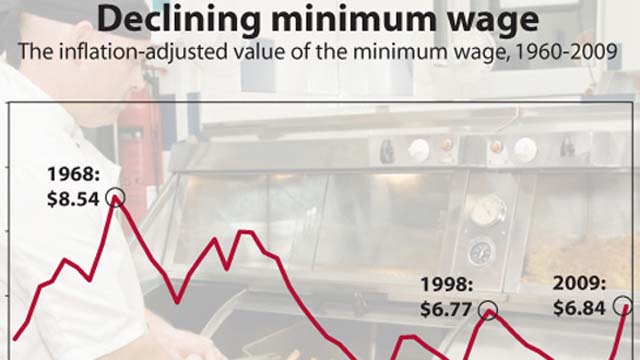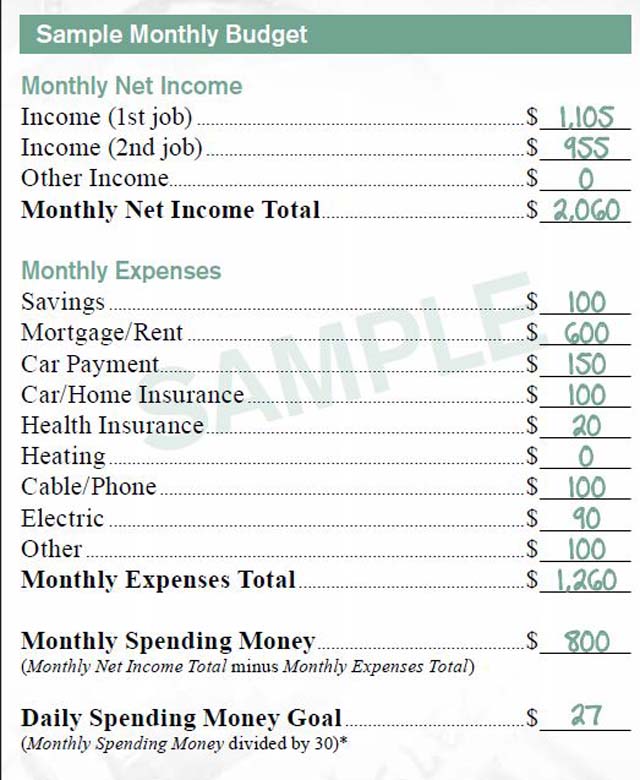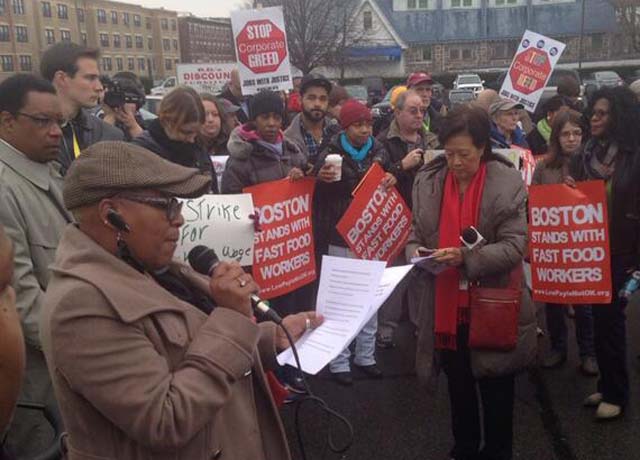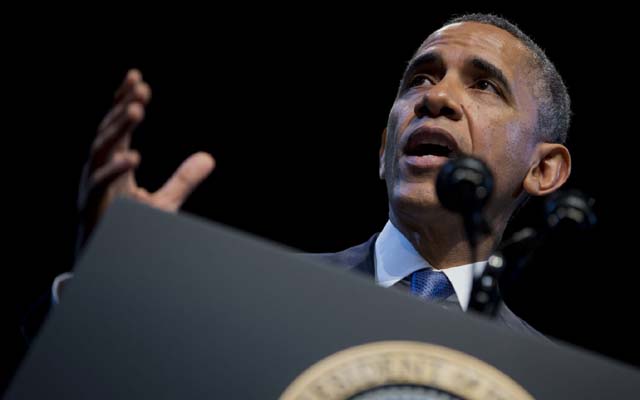
via Reuters
One year after the movement’s first major strike in New York City, fast food workers in over 100 cities across the United States are walking off their jobs. Here’s what you need to know:
1. The Minimum Wage in the United States Peaked in 1968

According to Pew Research when adjusted for inflation, the minimum wage reached its peak in 1968, when workers were guaranteed the equivalent of $8.56 an hour in 2012 dollars. In 2009, the federal minimum wage was raised to 7.25 an hour, leaving minimum wage workers 5.8% less purchasing power than they had at the end of the sixties.
That difficulty of surviving with that little buying power was helpfully illustrated this June, when McDonald’s created a financial planning site for its low-wage workers. The site offered workers a “Sample Monthly Budet” that showed them how easy it is to live on minimum wage working full-time, so long as they were working a second job at night, and didn’t have to pay any utilities:

via theatlantic.com
2. More Than a Quarter of Fast-Food Workers are Raising a Child

Buying power among lower income workers has decreased at the same time as the percentage of American jobs in low-paying fields has drastically increased.
According to the National Employment Law Project, while 60% of the jobs lost in the recession were in mid-wage occupations paying between 13.83 and 21.13 per hour, 58% of the jobs created in the wake of the recession have been in occupations that pay below $13.83 an hour.
The fast food industry has long argued that wage increases for its workers are not necessary because such a significant portion of their labor comes from young, part-time workers, as opposed to full adults looking for the sort of employment that could sustain a family.
But as the economy continues to bifurcate between high-skill professions in the tech and finance sectors, and low-skill work in the service sector, the stereotype of the greasy surburban teen flipping burgers for gas money is increasingly at odds with reality.

The Center for Economic and Policy Research released a report in August that found that 40% of fast food workers are 25 or older, more than 30% have some college experience, and 26.6% of fast food workers are raising children.
3. The Protests are Organized by the Service Employers International Union
The most legitimate criticism of the protests from the National Restauraunt Association, a food service industry lobbying group, is that those striking today represent a very small percentage of the workers employed in their industry.
Today’s protests, while reaching an impressive breadth of cities, are nonetheless composed of a relatively small number of strikers, compared to the landmark strikes of previous eras. The live updates RT.com is running often describe protestors by the dozen: “Dozens of people gathered around a Burger King in Dorchester, Massachusetts”:
Partial photo of #FastFoodStrike at Burger King in Dorchester, MA pic.twitter.com/IqqJnfqA0v
— Amy (@_greenlove_) December 5, 2013
The National Restaurant Association told USA TODAY they see the demonstrations as “a campaign engineered by national labor groups”, rather than one engineered by their workers independently.
According to In These Times, three organizers who began work on the campaign in Chicago in late 2011, say that from the beginning to goal was to unionize fast food workers, and that it became “increasingly clear that SEIU was directing the campaign.”
Some workers and field organizers within the campaign expressed concerns to In These Times that the “top-down organizing may benefit SEIU leaders at the expense of the workers.”
4. President Obama and Pope Francis Both Gave Speeches on Economic Inequality This Past Week

via thenation.com
A little over a week ago, Pope Francis delivered an address in which he denounced the “idolatry of money” and “trickle down economics”, saying:
“How can it be that it is not a news story when a homeless person dies of exposure, but it is news when the stock market loses 2 points?”
Obama included Francis’ quote in a wide-ranging speech Wednesday in which he described income inequality as the “defining challenge of our time”, and reiterated his support for Congressional Democrats’ plan to increase the minimum wage to $10.10 an hour, and require that number to increase with inflation.
5. 76% of Americans Support Minimum Wage Increase
Workers just shut down traffic on North Ave in #milwaukee to lift up the fight for $15 & a union. #FastFoodStrikes pic.twitter.com/OCA7ffbROa
— Wisconsin Jobs Now (@WiscJobsNow) December 5, 2013
A Gallup Poll from November found 76% of respondents would vote to increase the federal minimum wage, which is consistent with other polls taken on the issue over the last year.
Democrats plan to make the issue central to their 2014 congressional and senatorial campaigns.

